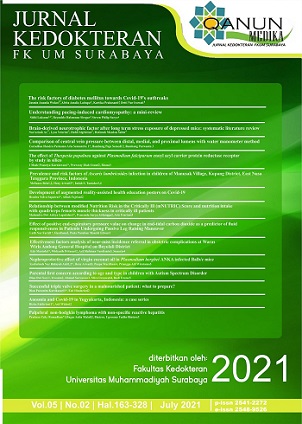Expression of Brain-Derived Neurotrophic Factor in the Brain of Depressed Mice: Systematic Literature Review
Abstract
Chronic stress exposure plays a role as a risk factor for depression. In chronic stress, there is prunning of nerve cell dendrites so that depression becomes irreversible. Depression is caused by low serotonin (5-HT2) neurotransmitters in the postsynaptic cleft. Recent findings in experimental animals indicate that serotonergic preparations are required to increase serotonin levels in the synapse opening, thereby triggering the formation of new dendrites to make depression reversible. The different results when these preparations create resistance in cases of chronic depression and actually increase the risk of uncomfortable and even fatal side effects with long-term use. This Systematic Literature Review uses the PubMed and Google Scholar databases for the period 2015-2020. A total of 322 articles at the beginning of identification and those that met the inclusion criteria in this study were six articles. The results of data extraction showed that the depression condition caused by various stressors resulted in BDNF levels in the hippocampus decreased significantly by p≤0.005. Based on the literature study, it was concluded that in depressive conditions, BDNF levels in the brain decreased.
Full text article
References
Antoniuk, S., Bijata, M., Ponimaskin, E., & Wlodarczyk, J. (2019). Chronic unpredictable mild stress for modeling depression in rodents: Meta-analysis of model reliability. In Neuroscience and Biobehavioral Reviews (Vol. 99, pp. 101–116). Elsevier Ltd. https://doi.org/10.1016/j.neubiorev.2018.12.002
Ghooshchi, S. G., & Jahromi, M. K. (2018). The effects of chronic and acute physical and psychological Stress on Brain-Derived Neurotrophic Factor in Rats. 2(2), 65–78.
Hawes, M., Galynker, I., Barzilay, S., & Yaseen, Z. S. (2018). Anhedonia and suicidal thoughts and behaviors in psychiatric outpatients: The role of acuity. Depression and Anxiety, 35(12), 1218–1227. https://doi.org/10.1002/da.22814
I. Tunisya, M. Maria Maramis, and A. K. (2010). Blood Serotonin Level With Depression Situation And Neurocognitive As A Reflection Of Neuron Condition In Six Months After Moderate Brain Injury.
Jeon, S. W., & Kim, Y. K. (2016). Neuroinflammation and cytokine abnormality in major depression: Cause or consequence in that illness? World Journal of Psychiatry, 6(3), 283. https://doi.org/10.5498/wjp.v6.i3.283
Macedo, I. C., Rozisky, J. R., Oliveira, C., Oliveira, C. M., Laste, G., Nonose, Y., Santos, V. S., Marques, P. R., Ribeiro, M. F. M., Caumo, W., & Torres, I. L. S. (2015). Chronic stress associated with hypercaloric diet changes the hippocampal BDNF levels in male Wistar rats. Neuropeptides, 51, 75–81. https://doi.org/10.1016/j.npep.2015.01.002
Qiao, Y., Zhao, J., Li, C., Zhang, M., Wei, L., Zhang, X., Kurskaya, O., Bi, H., & Gao, T. (2020). Effect of combined chronic predictable and unpredictable stress on depression-like symptoms in mice. Annals of Translational Medicine, 8(15), 942–942. https://doi.org/10.21037/atm-20-5168
Scotton, E., Colombo, R., Reis, C., Gabriela, M. P., Bristot, G., Salvador, M., Silva, T. M., Alessandra, E., Lopez, T. F., & Rosa, A. R. (2019). BDNF prevents central oxidative damage in a chronic unpredictable mild stress model: the possible role of PRDX-1 in anhedonic behavior. Behavioural Brain Research, September. https://doi.org/https://doi.org/10.1016/j.bbr.2019.112245
Shishkina, G. T., Bulygina, V. V., Agarina, N. P., & Dygalo, N. N. (2018). The Expression of Brain-Derived Neurotrophic Factor and Tryptophan Hydroxylase in the Dorsal Raphe Nucleus during Repeated Stress. Neurochemical Journal, 12(2), 152–154. https://doi.org/10.1134/s1819712418020101
Weisbrod, A. S., Barry, E. S., Graham, A. M., Eklund, M., & Grunberg, N. E. (2019). Decreased BDNF in female but not male rats after exposure to stress: a sex-sensitive rat model of stress? Stress, 22(5), 581–591. https://doi.org/10.1080/10253890.2019.1617692
Winer, E. S., Nadorff, M. R., Ellis, T. E., Allen, J. G., Herrera, S., & Salem, T. (2014). Anhedonia predicts suicidal ideation in a large psychiatric inpatient sample. Psychiatry Research, 218(1–2), 124–128. https://doi.org/10.1016/j.psychres.2014.04.016
Yang, T., Nie, Z., Shu, H., Kuang, Y., Chen, X., Cheng, J., Yu, S., & Liu, H. (2020). The Role of BDNF on Neural Plasticity in Depression. Frontiers in Cellular Neuroscience, 14. https://doi.org/10.3389/fncel.2020.00082
Authors

Qanun Medika by FK UM Surabaya is liscence under Lisensi Creative Commons Atribusi 4.0 Internasional.

